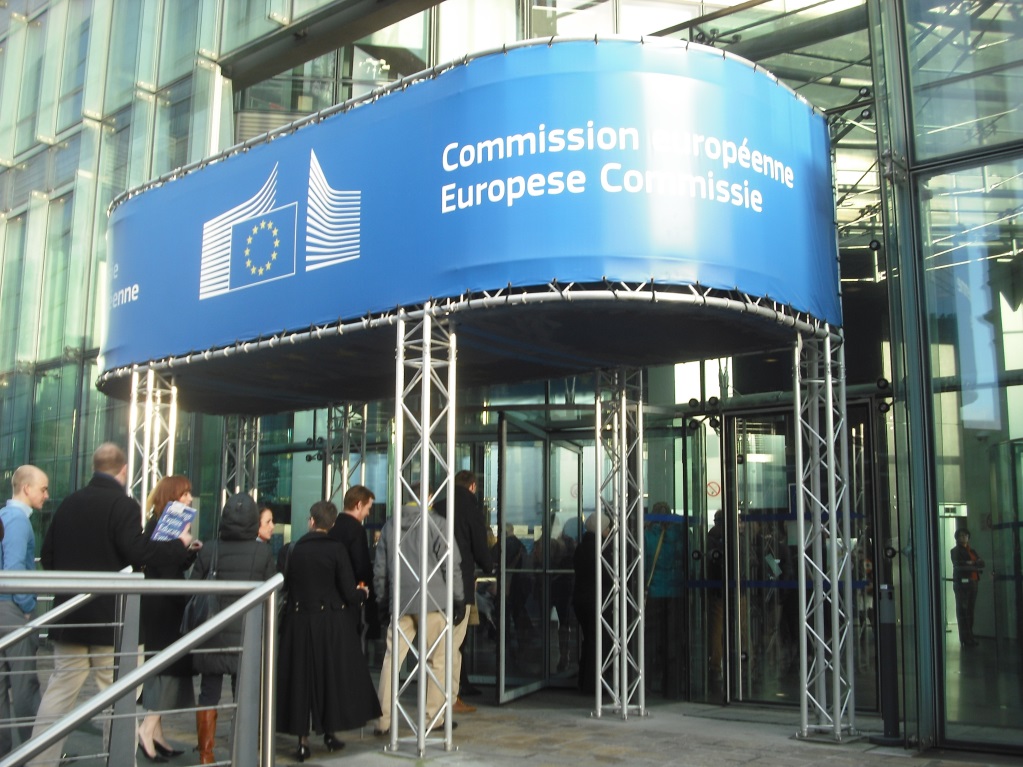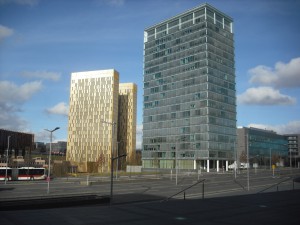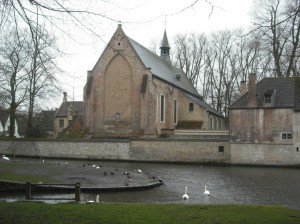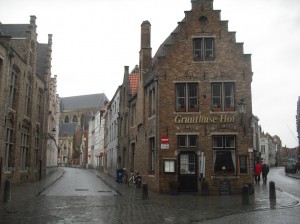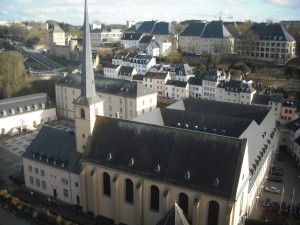Last month the Fulbright Commissions in Belgium and Spain provided me with the once-in-a-lifetime opportunity to represent Spain at the Fulbright Schuman Seminar on the European Union and NATO in Belgium and Luxemburg. I would like to take this opportunity to tell you a bit about my experience.
Fulbright Schuman is a unique program that allows grantees to do research in two or more different EU countries over the course of their grant year. The program invites Fulbrighters from each European country to its mid-year conference based in Brussels for four days of intensive learning about the European Union, NATO and the relationships the United States maintains with these two organizations. Let me give you a quick overview of the highlights of what we did, where we went, and what we learned.
On the first day we visited NATO headquarters, which is a sprawling complex on the outskirts of Brussels, and they are building an even more massive permanent headquarters across the street that looks like a row of giant aircraft hangers—very impressive. The briefings we received focused on how NATO has redefined its mission after the Cold War and on its current soul-searching as its long-running operations in Afghanistan come to an end. I am already finding what I learned there about NATO’S partnerships with non-member countries and its relationship with Russia useful as I follow the global diplomatic crisis surrounding Ukraine unfold.
That evening we attended a reception at the U.S. Ambassador to Belgium’s residence. The place was more small palace that house, complete with chandeliers and French-style paintings on the walls. It was clear that every detail was carefully considered so as to make the U.S. look as good as possible, even the mini-hamburgers served had U.S. flags on the toothpicks, and the paper hand towels in the bathroom had the U.S. Embassy seal on them. As if the reception wasn’t already charming enough, a man-and-wife piano and violin duo added original classical music to the air. This event, and another similar one we attended in Luxemburg, may seem all pomp and circumstance, but they are some of the most important things we do as Fulbrighters. In an era when funding for the program is waning, conveying to the public our excitement about the experience is essential for the future survival of Fulbright. These are the times when we feel like “cultural ambassadors” in a more literal way. If being an ambassador means free champagne in a fancy house, I am willing to oblige anytime.
The next day focused on the European Commission. I won’t review the EU’s extremely convoluted structure for you, but I will say that the European Commission is basically the EU’s executive body. Again, basically, it consists of a commissioner from each member state, and the commissioners work together to draft EU legislation, which then must be approved by the Council of the European Union (composed of relevant ministers from the member states) and the European Parliament (members elected by popular vote). The Commission is housed in a shiny new building in the heart of Brussels’ EU quarter, and it includes a visitors’ center on the first two floors. I was particularly interested in the presentation we heard about the European External Action Service, a new body that serves as the EU’s diplomatic corps. Only a few years old, its effectiveness as been questioned, but, again, the Ukrainian crisis may be its chance to come into its own.
Entering the European Commission headquarters.
Our final day brought us to the European Court of Justice in Luxemburg, which is the Supreme Court for matters regarding EU legislation. It is comprised of 28 judges, one from each member state of the EU, but it usually hears cases in chambers of three or five judges. The judges are assisted by nine Advocates-General, who are foreign to those of us accustomed to the American legal system with its thoroughly adversarial structure. An Advocate-General is assigned to each Court of Justice case and is responsible for investigating the case and giving a detailed opinion to the court to help it make its decision.
The European Court of Justice is housed in a cluster of towering buildings even fancier than the headquarters of the European Commission. The main edifice is filled with grand halls and contemporary artwork. The most impressive room was where the full court of 28 judges meets, with two stories of rooms for translators on the sides so that the case can be heard in every official language of the member states.
Part of the shiny EU complex in Luxemburg.
We had the exciting opportunity to see an actual court hearing inside the building; this one being heard by five judges. The case dealt with whether or not a German fruit juice could be labeled as both organic and healthy even if some non-organic supplements were added to meet the EU standards for a healthy product. The experience of hearing the case was fascinating. Unlike in the U.S. Supreme Court, the prosecution and defense did not make statements; instead, it was interested third parties, in this case, the French and Czech governments and the European Commission. The lawyers also got grilled by the judges, especially the Advocate-General. Perhaps the most interesting part was to see all the translators at work behind glass all around the room. German, which was the language of the case, was translated live into over half-a-dozen languages, and those translations were relayed to us through little earbuds, just like you see on the news.
I don’t want to give you the impression that the conference was all business suits and high-level briefings. It was also an opportunity for tourism in the beautiful countries of Belgium and Luxemburg. Belgium’s capital, Brussels, is the spitting image of the charming old European city with narrow stone streets, weathered brick buildings and a breathtaking center square. The food there tastes as good as the city looks. The waffles, fries, chocolate and meatballs all are more than deserving of their reputations. Then there is the beer. Amid the strong IPAs and stouts of the American craft beer craze, Belgian beers are still unequaled for their balance and refinement. Each one is served in its own unique glass in quite, wood paneled bars, while classical music plays softly in the background. It’s quite a contrast from the boisterous tapas scene in Madrid, where tile walls and late-night revelries make the noise-level too high for many proprietors to even bother with music.
These pictures are from a side trip to Bruges in Northern Belgium, a town which is like a mini-Brussels and, therefore, even more ridiculously charming than the capital.
The final day took us to the tiny country of Luxemburg. The two Fulbrighters there seem to have had some experiences similar to those of the Andorra ETAs, such as coffee with the Prime Minister and bumping into the Grand Duke out for a walk. With one of the highest per capita GDPs in the world, Luxemburgers can keep their country in immaculate condition. Litter is non-existent, and bikes are left unlocked. Buildings conform to a unique architectural style that features light-grey stone facades and blue-grey slate roofs. Their city perched on a cliff overlooking a blue-green river, Luxemburgers seem living proof of the old adage that money doesn’t buy happiness, but it sure can help!
By way of closing, I cannot forget to mention interacting with other Fulbrighters as another essential part of the Fulbright Schuman conference experience. I was a bit nervous at first about meeting so many different people in such a short time, but exchanging notes on different adventures as Fulbrighters around Europe made starting conversations easy. These chats quickly evolved into in-depth discussions of politics and history, for example, with people who were strangers just hours before. The quality and broad scope of the questions asked of the presenters, despite the fact that most of us came in with little knowledge of the EU, was also a testament to the wide-ranging interests and intellectual firepower that the Fulbright program assembles. The environment was so stimulating that the conversations often extended beyond the bus rides and receptions and into the night over a glass of fine Belgian beer. With the packed schedule demanding a 7AM breakfast (and one morning a 5AM departure), the one thing I felt I lacked during the conference was sleep.
Back in Spain now, I want to express my sincerest gratitude to the Fulbright Commission for honoring me with an experience that granted me new friendships with American Fulbrighters, new knowledge of the European Union and new perspectives on the relationship between the United States and Europe.
Foster Chamberlin
Fulbright Research Grantee 2013-14, Spain
